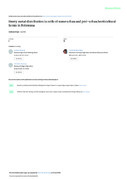Heavy metal distribution in soils of some urban and peri-urban horticultural farms in Botswana
| dc.contributor.author | Obuseng, L.C. | |
| dc.contributor.author | Meulenberg, F. Pule | |
| dc.contributor.author | Mubyana, T. John | |
| dc.contributor.author | Mpuisang, T. | |
| dc.contributor.author | Agbenin, J. | |
| dc.contributor.author | Oluko, Patrick Samba | |
| dc.contributor.author | Norton, J. | |
| dc.contributor.author | Okalebo, J.R. | |
| dc.contributor.author | Omondi, E. | |
| dc.contributor.author | N’getich, W. | |
| dc.contributor.author | Shikuku, D.S. | |
| dc.contributor.author | Okeyo, J.M. | |
| dc.contributor.author | Odhiambo, J.A. | |
| dc.contributor.author | Norton, U. | |
| dc.contributor.author | Ashilenje, D. | |
| dc.contributor.author | Wangoli, J.W. | |
| dc.contributor.author | Otiende, Verrah Akinyi | |
| dc.contributor.author | Mwanga, E.F. | |
| dc.contributor.author | Gitau, A.N. | |
| dc.contributor.author | Christiane, T. | |
| dc.contributor.author | Ernest, M. | |
| dc.contributor.author | Manuel, Joana | |
| dc.contributor.author | Matusse, Joaquim | |
| dc.contributor.author | Pimentel, Andréa Eloisa Bueno | |
| dc.contributor.author | Hess, S. | |
| dc.contributor.author | Hatab, A.A. | |
| dc.contributor.author | Da Silva, L.M. | |
| dc.contributor.author | Boly, H. | |
| dc.contributor.author | Glym, C. | |
| dc.contributor.author | Chibinga, O.C. | |
| dc.contributor.author | Musimba, N.M. | |
| dc.contributor.author | Nyangito, M. | |
| dc.contributor.author | Simbaya, J. | |
| dc.contributor.author | Elhag, M. Muna | |
| dc.contributor.author | Sulieman, M. Hussein | |
| dc.date.accessioned | 2019-05-27T15:48:20Z | |
| dc.date.available | 2019-05-27T15:48:20Z | |
| dc.date.issued | 2014-07 | |
| dc.identifier.uri | http://erepository.kibu.ac.ke/handle/123456789/1131 | |
| dc.description.abstract | Despite the fact that there is high usage of agrochemicals and use of urban waste water for irrigation, the concentration of potentially toxic metals in urban and peri-urban agriculture (UPA) farms has not been widely investigated in Botswana. The study focused on quantitative assessment of potentially toxic metals in horticultural production under UPA. Crops which are cultivated at the selected study sites include spinach (Spinacia oleracea L.), rape (Brassica rapa var. rapa.), cabbage (Brassica oleracea var. capitata), green pepper (Capsicum annum) and tomato (Solanum lycopersicum). Two farms from areas surrounding Gaborone namely Glenn Valley and Mmankgodi, were sampled for the determination of total heavy metals concentration in soils. In Glenn Valley secondary treated waste water is used for irrigation while in Mmankgodi underground water is used. Four soil profile pits were dug at each farm and soil samples of 20 cm increment were collected from the surface to a depth of 100 cm. Results showed concentration ranges of 0.12 - 1.22 mg/ L for Cr, 0.09 - 0.47 mg/L for Cu and from 0.01 - 0.24 mg/L for Pb. Copper and Chromium were above threshold levels for crop production (Cu 0.2 mg/L, Cr 0.1 mg/L) as per Food and Agriculture (FAO) standards and Botswana Bureau of Standards (BOBs), while Pb concentration was significantly higher at Glenn Valley than Mmankgodi, but below recommended threshold levels of 2.0 mg/L. These results are a wake-up call that policies on the use of sewage effluent and agrochemicals should be enforced. | en_US |
| dc.language.iso | en | en_US |
| dc.publisher | RUFORUM | en_US |
| dc.rights | Attribution-NonCommercial-ShareAlike 3.0 United States | * |
| dc.rights.uri | http://creativecommons.org/licenses/by-nc-sa/3.0/us/ | * |
| dc.subject | Soil profile | en_US |
| dc.subject | Threshold level | en_US |
| dc.subject | Toxic metals | en_US |
| dc.subject | Wastewater | en_US |
| dc.title | Heavy metal distribution in soils of some urban and peri-urban horticultural farms in Botswana | en_US |
| dc.type | Article | en_US |

